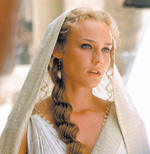| TV
Times
|
||||||
| ‘Troy’
: tipped to be the Epic of the Year Created in cinematic form Troy, features an ensemble cast boasting both rising talent and illustrious veterans of the stage and screen. Prince Hector of Troy is played by Eric Bana, star of Ang Lees Hulk and the critically acclaimed Australian film Chopper. Orlando Bloom, who first received widespread acclaim for his work in the Lord of the Rings trilogy, plays Hector’s younger brother, the recklessly charming Prince Paris, while Brad Pitt plays the all important role of the dreaded Greek warrior Achilles. It’s a stunningly handsome film, with an equally stunning cast and engrossing story and a movie like this almost has to reach the top ranks in its class to succeed. With its outsize budget and dense, rich literary-historical source (Homer’s “Iliad”), it’s a huge gamble in today’s youth-dominated blockbuster movie market. The story focuses on the two greatest warriors of ancient Greece: Achilles (Brad Pitt) and Hector (Eric Bana), both dragged into battle by circumstances out of their control. While Agamemnon uses his brother’s cause as an excuse to invade King Priam’s (Peter O’Toole) city, his real motivation is that its capture would ensure his control of the Aegean Sea. Arrogant, rebellious and seemingly invincible, Achilles has allegiance to nothing and no one, save his own glory. It is his insatiable hunger for eternal renown that leads him to attack the gates of Troy under Agamemnon’s banner but it will be love that ultimately decides his fate. Employing for the first time in moving making history the debut of “virtual stuntmen,” provided by leading visual effects houses The Moving Picture Company and Framestore CFC, employing technology pioneered by Natural Motion. The software, called “endorphin,” was developed from research into the neurobiology of human motion conducted by Oxford University’s Department of Zoology. The ingenious programme creates virtual characters whose bodies react exactly like real humans to whatever forces are applied to them unlike most computerized characters, which depend on fixed databases containing animated clips, endorphins virtual actors move independently, sensing and reacting to their environment in the same way humans do. This helps to create the mage battle environment where thousands of soldiers clash. Troy is inspired by The Iliad, the epic work attributed to the ancient poet Homer, considered to be the Western world’s original literary master. The epic poems Homer is credited with appear to have been composed in the 8th Century BC, 300-400 years after the supposed fall of Troy. While it isn’t clear whether Homer recited existing oral chronicles or was the sole and original creator, his work has survived the centuries to become literatures most compelling glimpse into the past. “There is an old saying that war brings out the worst and the best in human beings,” muses acclaimed producer/director Wolfgang Petersen. “But war is a disaster for everyone involved. While our film shows the spectacle of battle between tens of thousands of soldiers in a way that audiences have never seen before, the focus of our story is the timeless human aspect of the victories and defeats that Homer recorded.” Much of the production team’s research was accomplished through the British Museum, utilizing their collection of objects excavated from archeological digs in Turkey where the city of Troy is widely considered to have stood. There remains much speculation as to what Troy actually looked like during the period in which the events of The Iliad take place. Several different ancient cities have been discovered at the site, each built directly on top of the next. Troy VI is the level that represents the period that Phelps and his team were charged with recreating. Most of the film takes place in and around Troy, the main elements being the beach on which the Greeks land, the battlefield outside the city walls, the city itself and the palace within it. Other locations featured in Troy include the Thessalonian Valley in mainland Greece and the kingdoms of Sparta and Mycenae. “We were really trying to create a mood that would establish the different cultures,” says the settings man. “Agamemnon’s Mycenaean world is all about gold and wealth and property, as opposed to the Spartans, who lead such a barren, colorless existence. And then when we get to Troy, there’s a lot of greenery and it’s very pleasant.”, So its going to be the sight of where this epic battle took plays and features the iconic Trojan Horse as well. |
||||||
Copyright © 2001 Wijeya Newspapers
Ltd. All rights reserved. |
 Wolfgang
Petersen named 2001 Sho West Director of the Year after his epic
sea drama, The Perfect Storm (2000), and Noted for his remarkable
string of commercially and artistically successful films, credited
for direction and Production of the multiple-Academy Award nominated
box office smash Air Force One (1997), starring Harrison Ford, Gary
Oldman and Glenn Close brings to life the epic tale of all time,
the Trojan War.
Wolfgang
Petersen named 2001 Sho West Director of the Year after his epic
sea drama, The Perfect Storm (2000), and Noted for his remarkable
string of commercially and artistically successful films, credited
for direction and Production of the multiple-Academy Award nominated
box office smash Air Force One (1997), starring Harrison Ford, Gary
Oldman and Glenn Close brings to life the epic tale of all time,
the Trojan War.